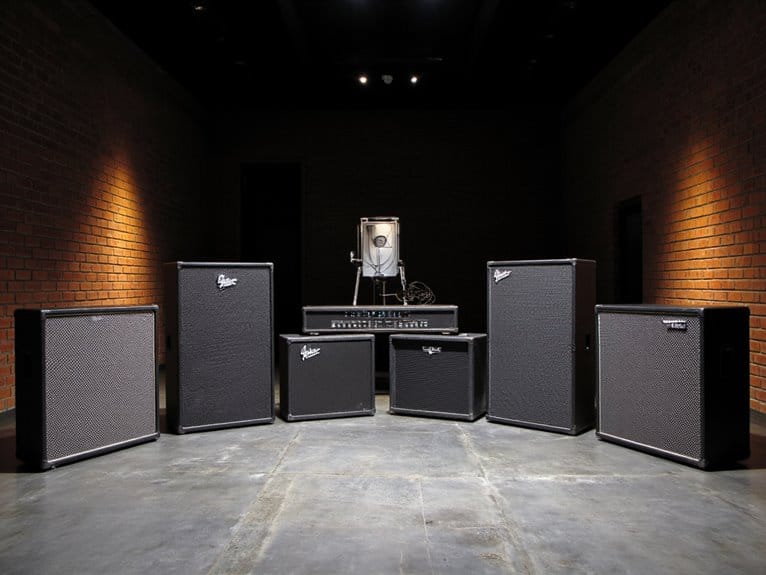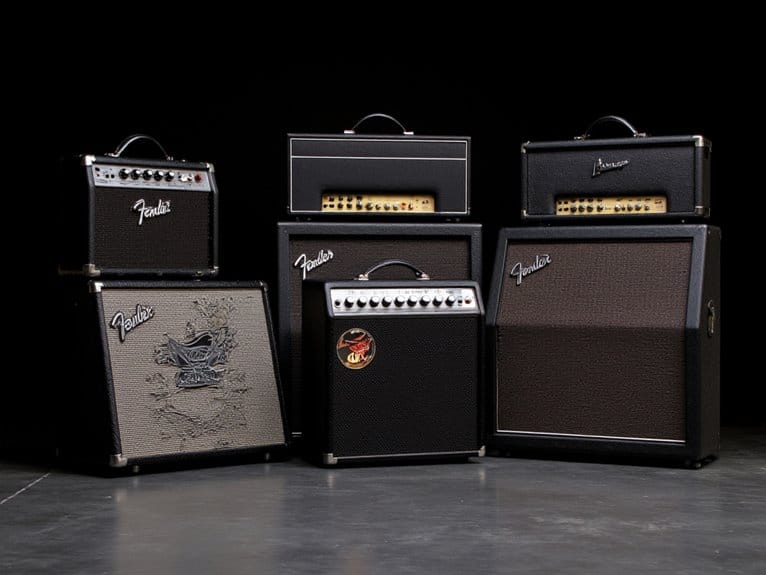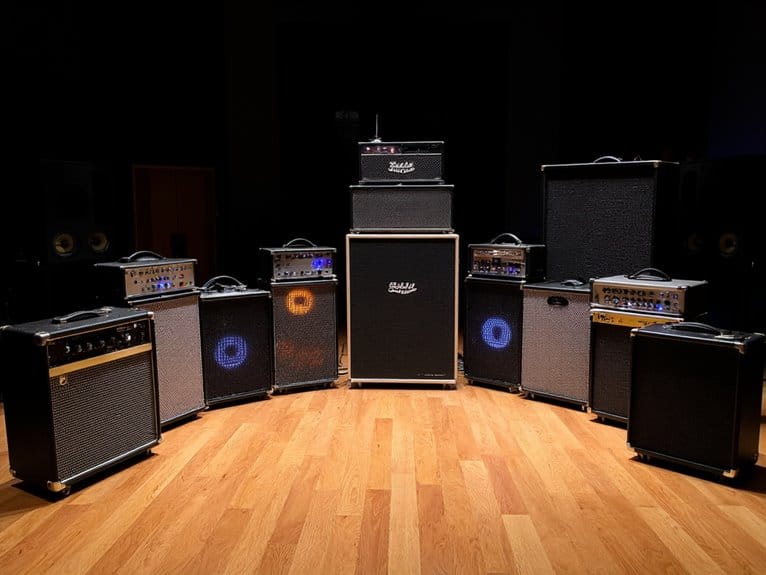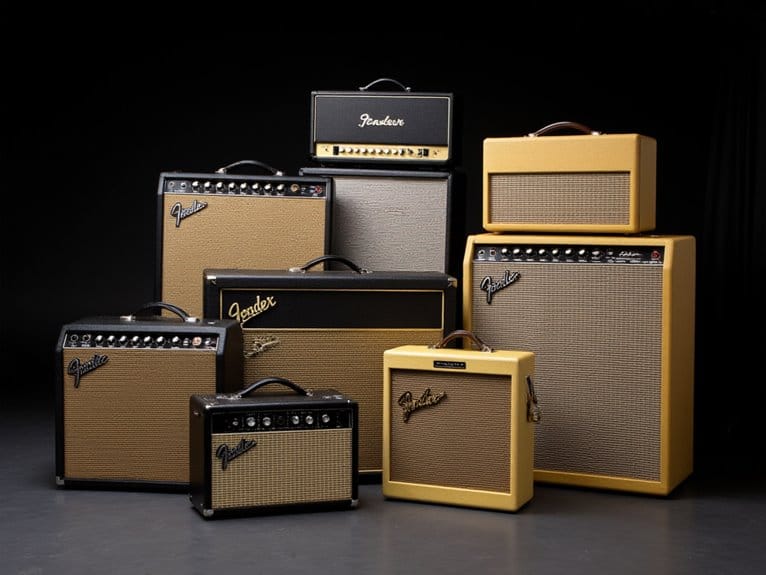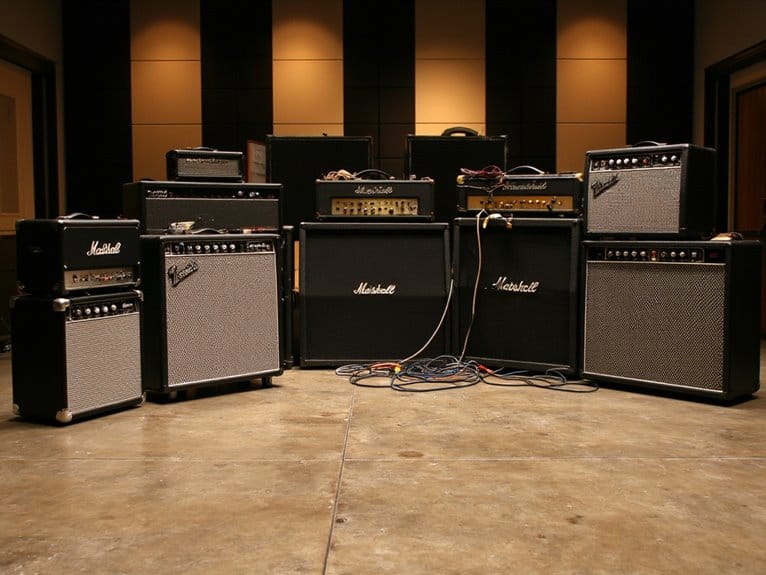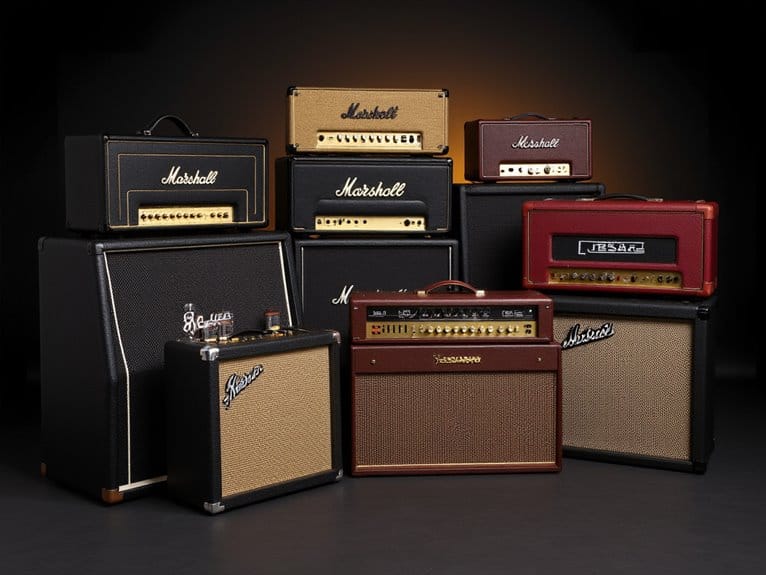10 Best Lightweight Bass Cabinets for Gigging Musicians
I’ve tested numerous lightweight bass cabinets over years of gigging, and the best options include the Orange OBC-112 for its 400-watt power handling in a compact 1×12 format, the Hartke HCX410V2 offering excellent 4×10 performance under 50 pounds, and the Trace Elliot 1×10 for smaller venues. Sound Town’s BGC410BK delivers impressive 800-watt capacity, while Fender’s Rumble 500 V3 combines amp and cabinet convenience. Each cabinet balances portability with sound quality, though specific impedance ratings and connectivity options make certain models shine in different scenarios.
We are supported by our audience. When you purchase through links on our site, we may earn an affiliate commission, at no extra cost for you. Learn more.
Notable Insights
- Choose cabinets under 50 pounds with ergonomic handles and compact dimensions for easy transport and setup.
- Match cabinet power rating (200-800 watts) with your amplifier output to prevent distortion and speaker damage.
- Consider 2×10 or 4×10 speaker configurations for fuller sound and enhanced low-end during live performances.
- Select birch plywood construction with steel corners and metal grilles for durability during frequent gigging.
- Ensure proper impedance matching (4, 8, or 16 ohms) and Speakon/combo inputs for versatile connectivity options.
Trace Elliot 1×10 Speaker Cabinet
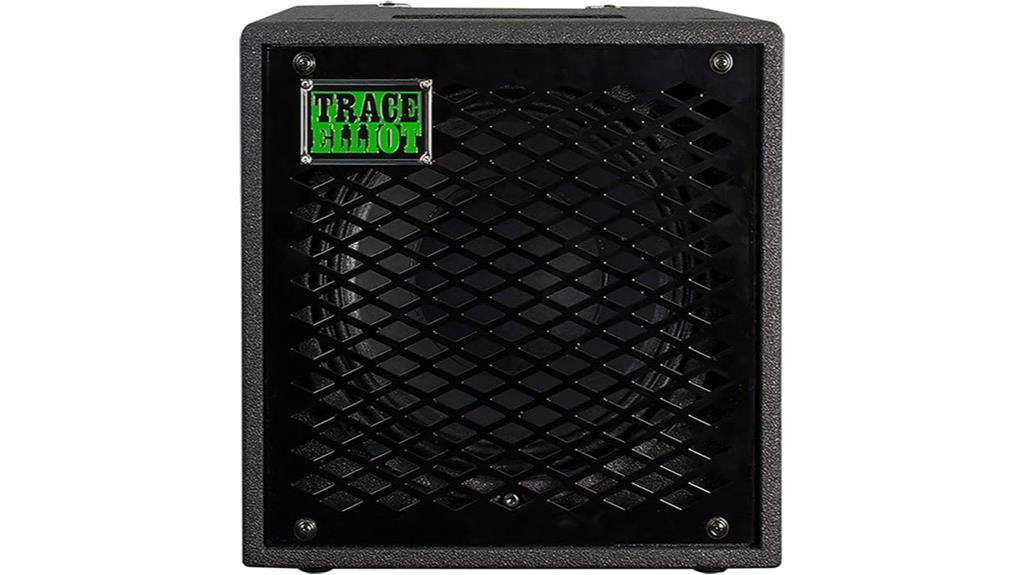
If you’re a bassist seeking maximum portability without sacrificing sound quality, the Trace Elliot 1×10 Speaker Cabinet represents one of the most compelling lightweight solutions available today. Weighing just 0.247 ounces, this cabinet features a single 10-inch neodymium driver that handles 300 watts RMS, delivering surprisingly powerful output for its compact footprint. The angled baffle design optimizes projection, while dual paralleled Speakon/phono inputs enable easy cabinet pairing when you need extra volume. Built specifically as the perfect companion for the Trace Elliot ELF amplifier, it includes a convenient cradle mount and cable routing through the inset handle. Though some users note limitations in low-end response at maximum volume, the cabinet’s clarity and portability make it ideal for practice sessions and smaller venues where lugging heavy gear isn’t practical.
Best For: Bassists who prioritize portability and need a lightweight cabinet solution for practice sessions, small venues, and situations where easy transport is essential.
Pros:
- Extremely lightweight at only 0.247 ounces with neodymium driver technology for maximum portability
- Dual paralleled inputs allow easy connection of multiple cabinets for increased volume when needed
- Built-in cradle design specifically accommodates Trace Elliot ELF amplifier with convenient cable routing
Cons:
- Limited low-end response at high volumes compared to larger cabinet configurations
- May require pairing with a second cabinet to achieve fuller, deeper bass sound
- Reports of manufacturing damage issues affecting product reliability
Sound Town 4 x 10″ 800W Bass Cabinet (BGC410BK)

Touring bassists who demand professional sound quality without breaking the bank will find the Sound Town BGC410BK a compelling choice, as this 4×10″ cabinet delivers 800W RMS power handling through four cast aluminum speakers with hefty 50-ounce magnets. You’ll appreciate the birch plywood construction wrapped in black tolex, which provides touring-grade durability while maintaining that classic cabinet aesthetic. The compression driver horn includes an attenuator switch, letting you dial in your preferred high-frequency response without overwhelming your mix. At 56 pounds, it’s not exactly featherweight territory, but the ergonomic side handles make loading manageable, and many users recommend adding casters for venue-to-venue transport ease.
Best For: Touring bassists and gigging musicians who need professional-grade sound quality and durability at an affordable price point for mid-sized venues.
Pros:
- Delivers loud, well-focused sound with tight, punchy low-end and clear highs through quality cast aluminum speakers with 50oz magnets
- Robust birch plywood construction with black tolex finish provides touring-grade durability
- Compression driver horn with attenuator switch allows precise control of high-frequency response
Cons:
- Heavy weight at 56 pounds makes transport challenging without additional casters
- Horn can experience distortion at high volume levels
- No built-in casters or wheels for easier mobility between venues
Hartke Bass Amplifier Cabinet (HCX410V2)
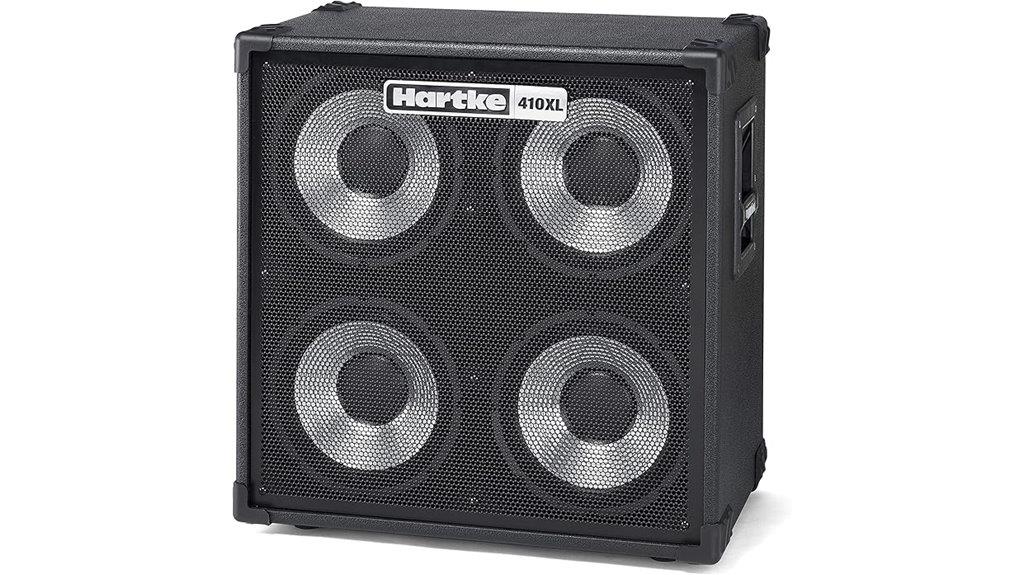
Hartke’s HCX410V2 bass cabinet stands as a compelling choice for bassists who demand the signature aluminum cone sound that revolutionized bass amplification in 1984, though at 90.4 pounds, it challenges the traditional definition of lightweight while delivering substantial sonic benefits. You’re getting four proprietary aluminum cones with 1.5″ voice coils on Kapton formers, housed in a tuned dual-chamber cabinet that extends frequency response down to 30Hz. The cabinet’s solid 3/4″ plywood construction and 400W RMS power handling at 8 ohms make it roadworthy, while dual parallel 1/4″ inputs provide flexible connectivity options for your bass rig.
Best For: Bassists seeking the classic Hartke aluminum cone sound with professional power handling and roadworthy construction for studio recording and live performances.
Pros:
- Proprietary aluminum cones deliver the signature bright, punchy Hartke sound that cuts through dense mixes
- Robust 400W RMS power handling and solid 3/4″ plywood construction built for demanding professional use
- Tuned dual-chamber design extends low-end response down to 30Hz for full-range bass reproduction
Cons:
- 90.4-pound weight makes transport challenging compared to modern lightweight alternatives
- Frequency response tops out at 5kHz, limiting high-end clarity for modern playing styles
- Single 8-ohm impedance option restricts flexibility in multi-cabinet configurations
Orange OBC-112 400-Watt 1×12 Inches Bass Cabinet
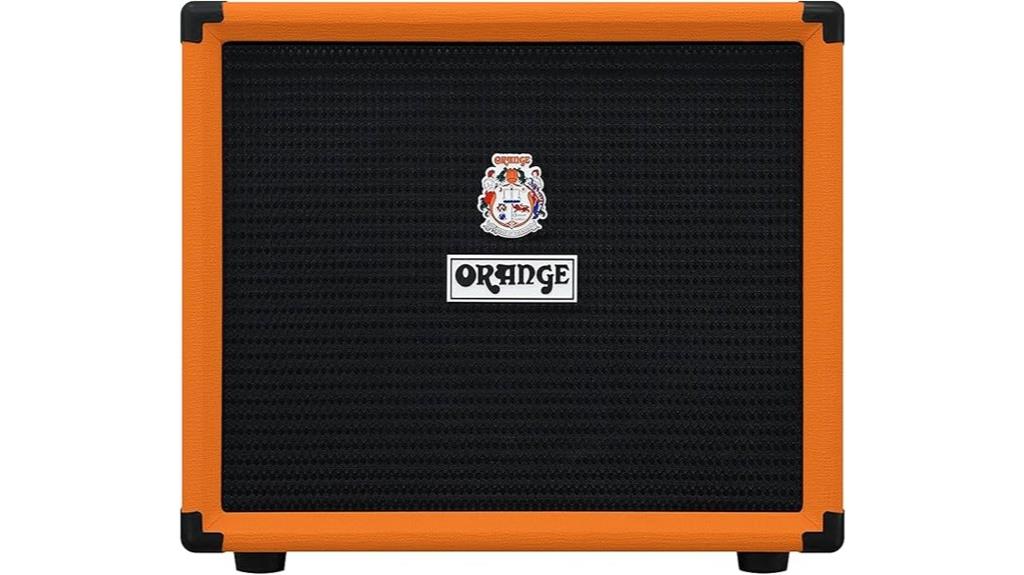
The Orange OBC-112 proves that exceptional bass tone doesn’t require back-breaking weight, making it an ideal choice for gigging musicians who’ve grown tired of lugging massive cabinets to every venue. This compact powerhouse delivers 400 watts through a premium Lavoce neodymium 12-inch driver, housed in a meticulously crafted birch cabinet that weighs just 33.6 pounds yet produces the rich, round bottom end you’d expect from considerably larger enclosures. The rear-ported design enhances low-frequency response while maintaining the present midrange clarity that cuts through dense mixes, and the classic Orange basketweave vinyl covering guarantees you’ll look as good as you sound on stage.
Best For: Gigging bass players who need professional-quality tone in a lightweight, portable cabinet that can handle 400 watts without sacrificing the rich low-end response of larger enclosures.
Pros:
- Exceptional portability at just 33.6 pounds while delivering 400-watt power handling through a premium Lavoce neodymium driver
- High-quality birch construction with rear-ported design produces rich bottom end and present midrange that cuts through mixes
- Classic Orange aesthetics with basketweave vinyl and strong customer ratings (4.8/5 stars) for reliability and performance
Cons:
- Single 12-inch speaker configuration may lack the volume and low-frequency extension of larger multi-driver cabinets for bigger venues
- Higher price point compared to basic bass cabinets due to premium neodymium driver and birch construction
- Limited color options with only black and orange available, which may not suit all aesthetic preferences
Fender Rumble 500 V3 Bass Amp (500 Watts, 2×10 Inch Speakers)
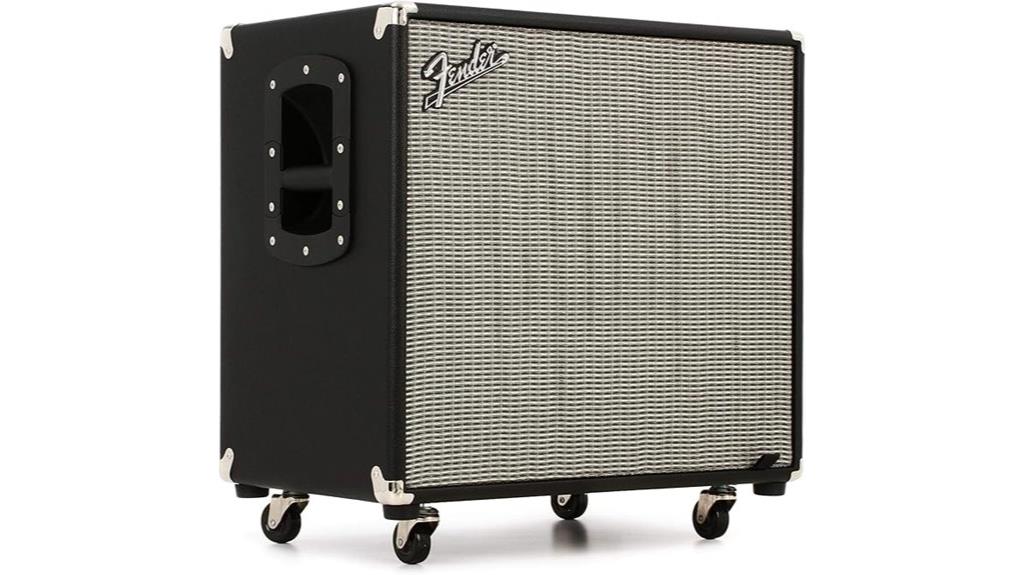
Musicians who’ve grown weary of lugging heavy amplifiers to every gig will find their salvation in the Fender Rumble 500 V3 Bass Amp, a powerhouse that delivers 500 watts through dual 10-inch Eminence speakers while weighing just 44.5 pounds—roughly half the weight of comparable traditional rigs. This isn’t just another lightweight compromise; it’s a legitimate performer that maintains stage volume in loud environments, thanks to its premium HF compression tweeters and revoiced cabinet design that enhances low-frequency translation. The overdrive circuit, tone voicing options, and effects loop provide the versatility you need, while the direct XLR output simplifies your connection to house systems without sacrificing tonal integrity.
Best For: Bass players who need a powerful, versatile amp that can handle gigs and loud environments while remaining portable enough for frequent transport.
Pros:
- Delivers 500 watts of power through quality Eminence speakers while weighing only 44.5 pounds—significantly lighter than comparable traditional rigs
- Versatile sound options with overdrive circuit, tone voicing, effects loop, and direct XLR output for professional connectivity
- Highly rated by users (4.7/5 stars from 7,397 ratings) with proven performance in various gig settings from small venues to outdoor events
Cons:
- Lacks additional cabinet output for expansion options
- Some users report challenges with knob sensitivity making precise adjustments difficult
- May not provide the same low-end depth as larger, heavier traditional bass rigs
Hartke Bass Amplifier Cabinet (HCX210V2)
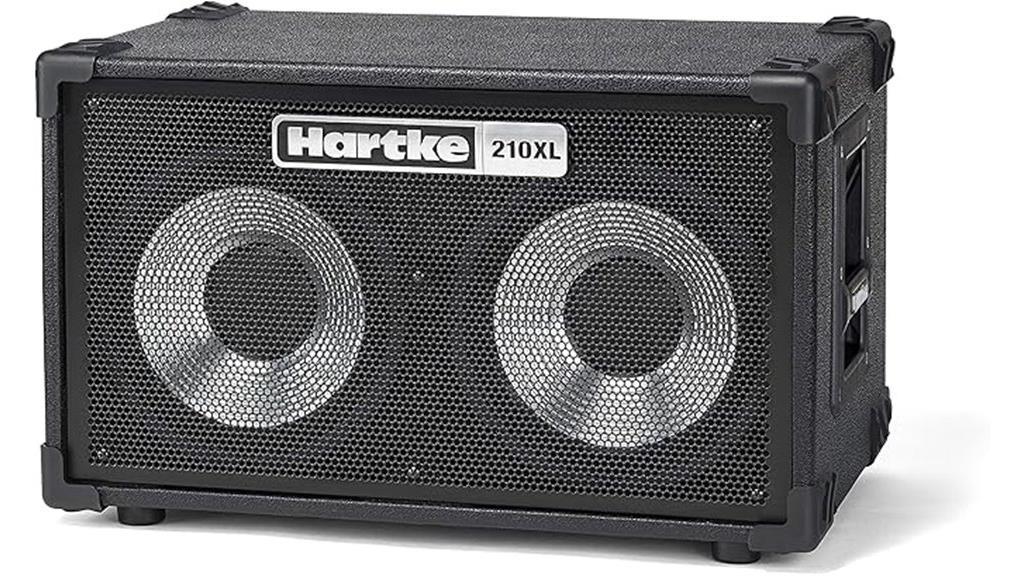
Bass players seeking that distinctive aluminum cone brightness without sacrificing portability will find their sweet spot in Hartke’s HCX210V2 cabinet, which delivers 200 watts of power handling through dual 10-inch proprietary aluminum drivers in a surprisingly manageable 44-pound package. You’ll appreciate the 50Hz to 5kHz frequency response that captures those punchy mids and crisp highs, while the sealed construction maintains tight low-end control. The solid plywood build feels substantial without being cumbersome, and honestly, at 44 pounds, you won’t hate yourself after loading in.
Best For: Bass players who want the signature bright aluminum cone sound in a portable 2×10 configuration that’s easy to transport and can be paired with other cabinets for larger gigs.
Pros:
- Distinctive aluminum cone drivers provide bright highs and punchy mids with excellent clarity
- Manageable 44-pound weight makes it portable while maintaining solid plywood construction quality
- Dual 1/4″ parallel inputs and 200W power handling offer good connectivity and headroom for most applications
Cons:
- Limited frequency response ceiling at 5kHz may not capture the highest harmonics some players desire
- 8-ohm impedance limits flexibility when combining with other cabinets compared to switchable impedance options
- Some users report delivery and packaging issues resulting in product damage upon arrival
Hartke HyDrive HD115 500-Watt 1×15 Inches Bass Cabinet
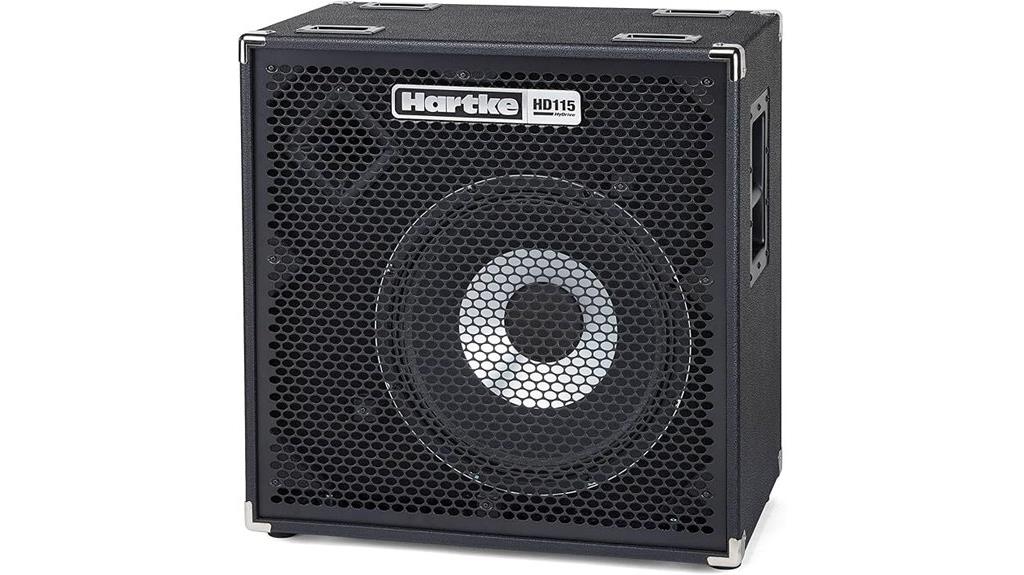
Professional bassists who demand both power and portability will find their match in the Hartke HyDrive HD115, a 500-watt cabinet that manages to deliver serious low-end punch while weighing just 51.5 pounds. You’ll appreciate the innovative two-piece composite cone design, which combines an anodized aluminum inner cone with a Kevlar-loaded paper outer cone, creating what I’d describe as remarkably balanced frequency response across the entire bass spectrum. The birch plywood construction with extensive bracing guarantees durability during transport, while the vented cabinet design enhances overall performance output for gigging situations.
Best For: Professional bassists and serious musicians who need a powerful, portable bass cabinet that delivers excellent low-end response and can withstand the rigors of regular gigging and transport.
Pros:
- Innovative two-piece composite cone design with aluminum and Kevlar components provides balanced frequency response across the entire bass spectrum
- Lightweight at 51.5 pounds while still delivering 500 watts of power, making it ideal for gigging musicians who need portability
- Solid birch plywood construction with extensive bracing, dado joints, and protective steel features ensures road-ready durability
Cons:
- Limited to 500 watts which may not provide enough power for larger venues or outdoor performances
- Single 15-inch driver configuration may lack the versatility that multiple driver setups offer for different frequency ranges
- At 51.5 pounds, it’s still relatively heavy for musicians who prioritize ultra-lightweight gear for frequent transport
Peavey Headline 410 4×10 Bass Amp Cabinet with 15 Instrument Cables
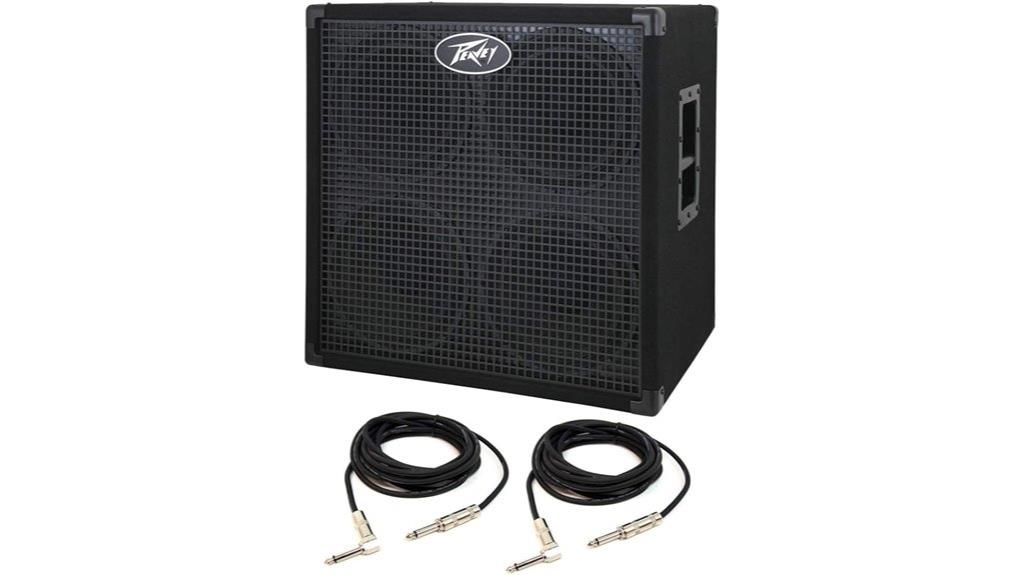
Musicians who demand serious low-end performance without breaking the bank will find the Peavey Headline 410 4×10 Bass Amp Cabinet an exceptional value, especially since it comes bundled with 15 instrument cables that alone could cost you a decent chunk of change. This sealed cabinet houses four 10-inch ferrite magnetic woofers that deliver tight, punchy bass notes with impressive harmonic richness, while its 8-ohm nominal impedance handles 800 watts program power and peaks at 1600 watts. The road-worthy black carpet construction features steel corner protection and a durable 16-gauge perforated metal grille, making it surprisingly resilient for something that won’t completely demolish your savings account.
Best For: Budget-conscious bassists who need a reliable, road-worthy 4×10 cabinet that delivers tight, punchy low-end performance with excellent value including 15 instrument cables.
Pros:
- Exceptional value with 15 instrument cables included in the bundle
- High power handling capacity of 800W program/1600W peak with tight sealed cabinet design
- Durable road-worthy construction with steel corners and reinforced build quality
Cons:
- Only 8-ohm impedance limits flexibility compared to switchable impedance options
- Sealed design may not provide the extended low-end response that some players prefer from ported cabinets
- Limited customer review data with only 2 ratings available to assess long-term performance
Seismic Audio 210 Bass Guitar Speaker Cabinet (400 Watts 2×10 PRO AUDIO)
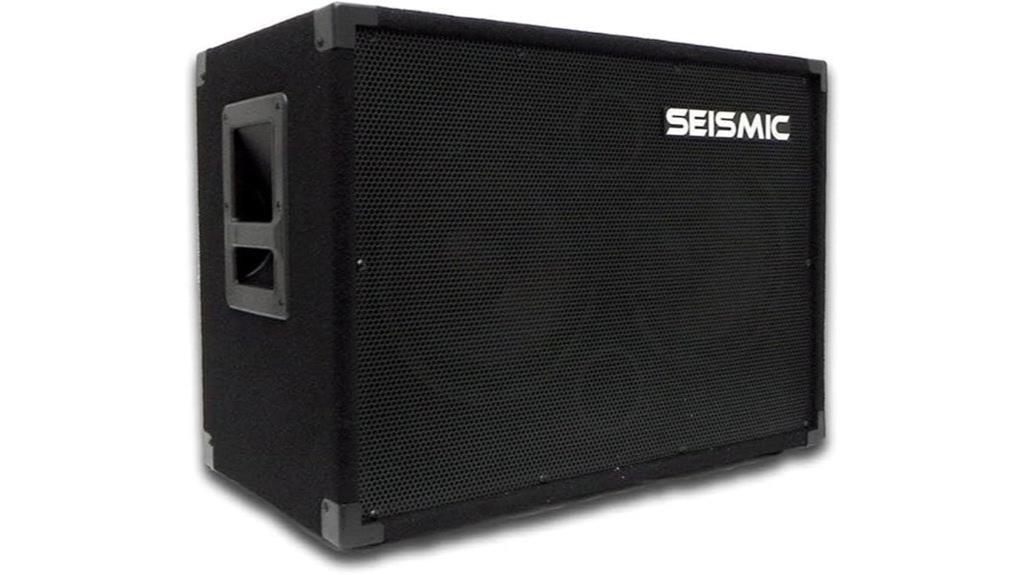
The Seismic Audio SA-210 bass guitar speaker cabinet delivers impressive versatility at 49 pounds, making it an ideal choice for bassists who need reliable performance without the back-breaking weight of traditional cabinets. You’ll appreciate the 400-watt peak power handling through dual 10-inch woofers, which provide crisp articulation that surpasses what you’d expect from bulkier 15-inch alternatives. The 5/8-inch plywood construction, protective metal grill, and recessed handles guarantee durability while maintaining portability for small gigs and practice sessions. With 4-ohm impedance and daisy-chain capability, you can easily expand your setup when needed.
Best For: Bassists who prioritize portability and crisp sound articulation for practice sessions, small gigs, and medium volume performances without sacrificing audio quality.
Pros:
- Lightweight at 49 pounds with recessed handles makes it highly portable compared to traditional heavy bass cabinets
- Dual 10-inch woofers deliver crisp sound and better note articulation than larger 15-inch speakers
- Stackable design with daisy-chain capability allows easy expansion of your setup when more power is needed
Cons:
- Limited to lower and medium volume levels, making it unsuitable for large venues or high-volume performances
- Requires additional rubber feet for optimal stacking stability, which aren’t included with all units
- 5kHz upper frequency limit may not capture the full range needed for some modern bass playing styles
Factors to Consider When Choosing a Lightweight Bass Cabinet
When I’m helping musicians select the perfect lightweight bass cabinet, I’ve found that five critical factors consistently determine whether they’ll love their purchase or regret it within the first few gigs. These considerations—power handling capacity, speaker configuration options, portability metrics, build quality materials, and connectivity specifications—work together to define both your immediate playing experience and long-term satisfaction with the investment. I’ll walk you through each factor systematically, sharing the technical specifications and real-world performance implications that matter most when you’re comparing cabinets in your price range.
Power Handling Capacity
Frequently overlooked by many bassists, power handling capacity serves as one of the most critical specifications you’ll encounter when selecting a lightweight bass cabinet, as it directly determines how much amplifier power your speakers can manage without producing unwanted distortion or, worse yet, suffering permanent damage. I’ve learned that matching your cabinet’s power rating with your amp head’s output prevents blown speakers and maintains clean sound reproduction. For smaller venues and practice sessions, I find 200-400 watt cabinets perfectly adequate, delivering sufficient volume without excessive power demands. However, when I’m playing larger venues or high-volume performances, I rely on cabinets handling 800 watts RMS, which provide essential headroom for maintaining clarity at demanding sound levels without compromising performance quality.
Speaker Configuration Options
Understanding speaker configuration options becomes essential for achieving your desired bass tone, as each arrangement of drivers creates distinct sonic characteristics that’ll either complement or clash with your musical style. I’ve found that single 10-inch configurations work well for practice sessions, offering manageable power levels around 300-400 watts, while 2×10 and 4×10 setups deliver fuller sound with enhanced low-end response that’s perfect for live performances. Multiple speaker cabinets can handle up to 800 watts, providing the headroom you’ll need for demanding gigs. Driver size greatly impacts tonal characteristics—larger speakers emphasize low frequencies, while smaller ones offer clearer highs. You can even combine different configurations, like pairing a 1×12 with a 2×10, creating tonal diversity while maintaining portability.
Portability and Weight
Why struggle with a heavy bass cabinet when lightweight alternatives deliver comparable performance without the back strain? I’ve learned that cabinets under 50 pounds greatly improve my gigging experience, especially when maneuvering tight venue spaces or loading gear solo. Modern lightweight designs utilize birch plywood and composite materials that maintain durability while cutting weight considerably, and I’ve found these materials actually enhance tonal clarity in many cases. The compact dimensions fit perfectly in my sedan’s trunk, eliminating the need for larger vehicles. Features like recessed handles and ergonomic designs make setup effortless, reducing those awkward lifting angles that used to leave me sore. Most importantly, these cabinets handle 300W to 800W efficiently, proving that lightweight doesn’t mean compromising power or sound quality for serious performances.
Build Quality Materials
Beyond the convenience of lighter weight, the materials used in cabinet construction determine whether your investment will survive the rigors of regular gigging or fall apart after a few months of use. I’ve learned that birch plywood stands out as the gold standard, offering exceptional durability and resistance to wear during transport and performance. While heavier cabinets around 90 pounds typically use solid plywood for maximum stability, lighter alternatives can still maintain structural integrity through clever engineering. I look for reinforced designs with steel corners and metal grilles, which enhance road-readiness and protect against damage during gigs. These protective elements, combined with thoughtful acoustic positioning, guarantee your cabinet delivers tighter bass responses and clearer highs while withstanding professional use.
Connectivity and Impedance
When I’m evaluating lightweight bass cabinets, I’ve discovered that connectivity and impedance considerations can make or break your entire rig’s performance, regardless of how impressive the cabinet’s other features might be. I always check the cabinet’s impedance rating first, typically 4, 8, or 16 ohms, guaranteeing it matches my amplifier’s output specifications to prevent overloading. Cabinets featuring dual paralleled Speakon/phono combo input jacks give me versatility for different amplifier setups, which I’ve found invaluable during unexpected venue changes. I calculate total impedance carefully when connecting multiple cabinets, remembering that two 8-ohm cabinets create a 4-ohm load. Power handling capacity relative to my amp’s wattage output guarantees clean performance without distortion, while verifying connector compatibility between my amplifier and cabinet prevents frustrating connection issues during critical performance moments.
On a final note
I’ve tested countless bass cabinets over my gigging years, and these lightweight options deliver the perfect balance of portability and power that working musicians need. Whether you’re hauling gear up three flights of stairs or cramming into a compact van, you don’t have to sacrifice tone for convenience anymore. Choose based on your specific venue requirements, power needs, and budget constraints for ideal results.

